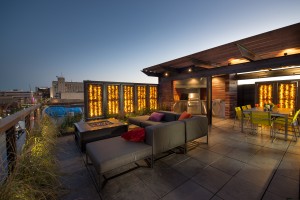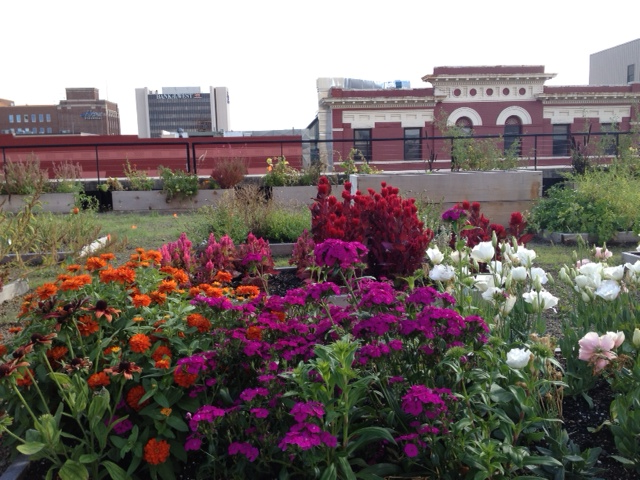November 6, 2012
Up on a Roof: Green roofs boast environmental, aesthetic advantages
Almost as soon as humans figured out how to build roofs, they’ve wanted to plant gardens atop them.
The use of vegetation on roofs dates back to the Hanging Gardens of Babylon and the design of early Viking abodes. The oldest green roof in the United States (if you don’t count early settlers’ sod homes!) is the 82-year-old paradise atop New York’s Rockefeller Center.
In the last 15 years, we’ve seen a steady greening of America’s roofs. It’s not surprising that progressive cities like New York, Chicago and Portland would be leaders in this technology, but it’s less expected to see that trend reach a smaller community like Fargo.
But guess what? Green roofs are right here in downtown Fargo, and people can’t seem to get enough of them.
Mike Allmendinger, Kilbourne Group general manager, recently presented a TEDx Adventures tour of downtown Fargo’s green roofs. A landscape architect whose firm, Land Elements, installed these living roofs, Allmendinger took participants on tours of KG rooftops at 102 Broadway and 300 Broadway.
The revitalization group plans to include a green roof atop another prominent Broadway fixture, The Loretta Building, as well. Green roofs can also be found on non-KG properties like downtown’s Hotel Donaldson and Starion Financial in south Fargo).
Although the prairie grass atop the 102 rooftop had begun to go dormant at the time of Allmendinger’s tour, the roof still showed plenty of evidence of the previous summer’s successful growing season. Raised beds still showed the harvested remains of gardener/Prairie Petal owner Kimberly Hess’s perennials, native prairie plants and vegetable gardens. Allmendinger pulled up a concrete paver on the rooftop to give participants a peek at the ingenious system that allows grass to grow and vegetables to thrive on a rooftop.

KG’s green roofs sprout not from heavy, Red River Valley soil but from a few inches of a high-tech, engineered growing medium. Plant selection also plays an important role in a green roof’s success. Low-maintenance, low-water plants like sedums are an ideal candidate for rooftop gardening, he added. (Even so, some irrigation is needed.)
The growing medium rests atop an insulated drainage, aeration and water storage system. Beneath this egg carton-like layer is a waterproof membrane, which protects the building from water leaks and acts as a root barrier. Beneath this is the extra structural support which is needed to carry the considerable weight of soil, plants and irrigation systems. (Fortunately, 102 is a concrete building, rumored to be built with the intent to park cars on its rooftop, so was easily able to shoulder the weight of a green roof.)
He explained some of the advantages to green roofs:
- Storm water management: They reduce the flow rate and decrease the amount of storm water that dumps into local water systems. Allmendinger says 97 percent of the precipitation collected on 102’s green roof is used rather than drained into the river. Plants will also act as a filter, removing pollutants from storm water.
- Structural protection: The vegetation acts as a buffer, protecting roofs from the punishing effects of temperature extremes, high winds and heavy precipitation. According to a research paper from the University of California-Davis Extension, green roofs can double the life of a roof from 15 to 30 years.
-
Energy efficiency: It can cost a pretty penn, $1 to $6 more per square foot, to install a green roof instead of a conventional one. However, proponents claim if builders can get past the sticker shock, green roofs eventually pay off. The technology keeps internal building temperatures more stable, resulting in long-term energy savings.
Plants, which naturally convert sunlight to chlorophyll and water into cooling mist, also help reduce the heat island effect triggered by large expanses of urban asphalt and concrete, according to the UC Davis paper.
-
Added value: Green roofs can boost property values and re-energize underutilized areas.
And then there are the (considerable) aesthetic benefits. Numerous studies point to the physical and mental advantages we glean from natural environments, and green roofs help us connect to Mother Nature amid the densest of concrete jungles.
“People just love being on roofs,” Allmendinger says. “It’s like a treehouse. They have a natural draw.”

